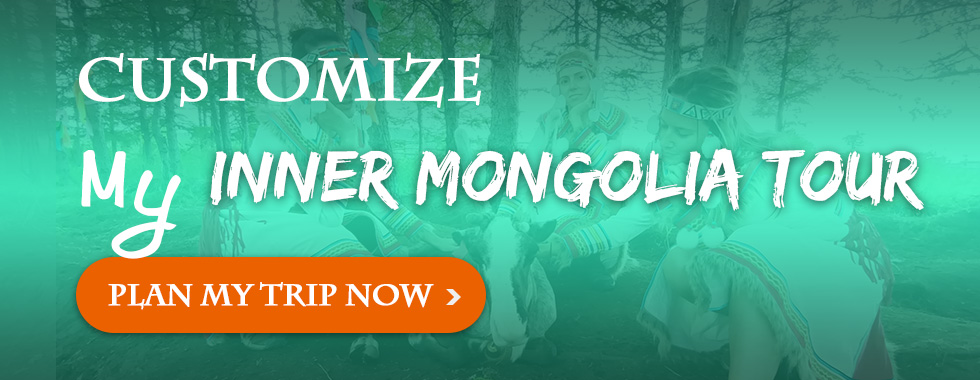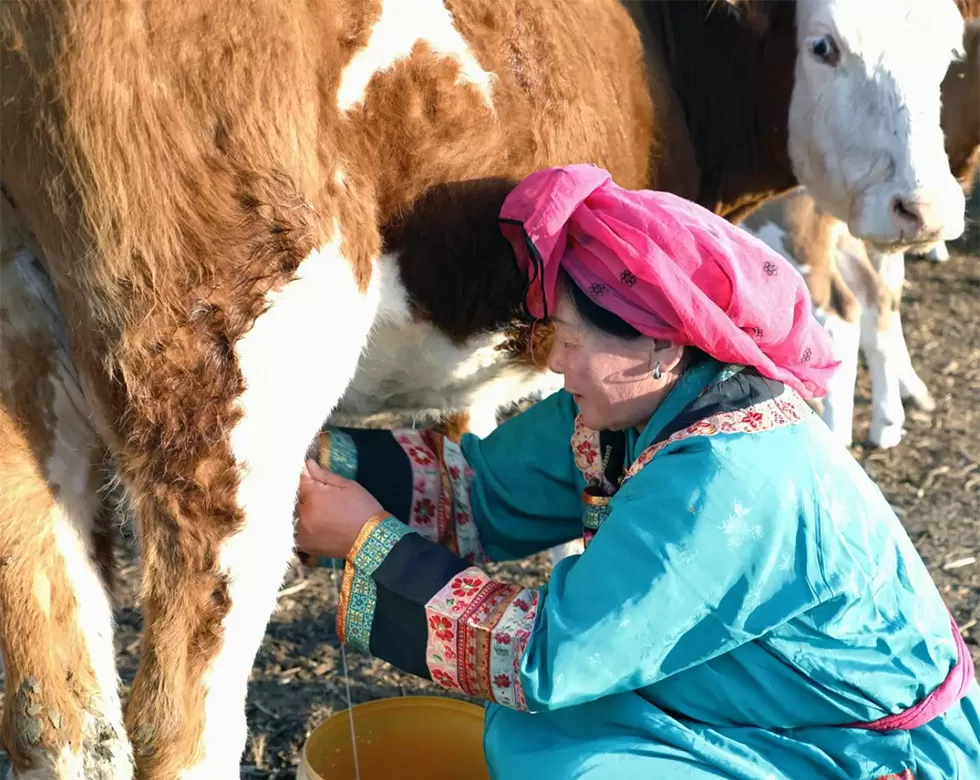Top Inner Mongolia activities and outdoor Adventures
Rolling grassland, shimmering river, and golden desert, spectacular sceneries expand towards the horizon. In this boundless space of Inner Mongolia, meet the nomadic herders who chase their flocks for better pasture, and encounter some ethnic people that still live the traditional way of life. Find a connection between land and sky, man and nature here, and catch the secret of “eternal growth” hidden in the whispering wind.
Perseverance and effort are required for overland travel in Inner Mongolia, making it hardly a magical experience. Yet, those who persist will eventually encounter an unforgettable journey in Inner Mongolia.
Mongolian cheese curd making

- Type: Cultural Immersion/ Food
- Duration: 2 hours
- Location: Hohhot
The diet of the Mongols living in Inner Mongolia was greatly influenced by their nomadic way of life with dairy products and meat. One of the main staples of nomadic Mongols is dried milk curd also known as “qurut” or “aaruul” which is made of drained sour milk.
 Cheese Curd
Cheese CurdTo make qurut, yogurt is boiled till it starts to form clumps and harden, before filtering through a cheesecloth to get milk curd. The curd is then wrapped with cloth and pressed by heavy rocks to squeeze out the liquid. Compressed curd is then cut into pieces and dried under the sun. Rich in protein and calcium, it is a common travel provision and one of the main vitamin sources for nomads. They will prepare a sufficient amount of dried cheese curds in the summer for them to push through the hushed winter. Dried cheese curds can be stored for a long period if stored properly. Light brown with a sour and milky taste, dried milk curd can either be eaten directly in solid or dissolved in a bowl of hot water.
Nowadays, with most nomads moving into city areas, it is hard to find the most traditional way of making dried milk cheese. We will visit a local in Hohhot and try our hand at making this special Mongolian staple in a new way.
Morin Khuur making

- Type: Cultural Immersion/ Art & Architecture
- Duration: 2.5 hours
- Location: Hohhot
Morin Khuur, also known as the horse-head fiddle, is a traditional bowed string instrument of Mongols. This instrument is played by sliding the bow against two strings with the right hand and pressing on the strings to change notes using the left hand. It is an important musical instrument that has figured prominently in the nomad culture of Inner Mongolia. Commonly play in solo, it can also accompany songs and dances occasionally.
 Morin Khuur Making
Morin Khuur MakingIn Hohhot, we will meet a craftsman, take a closer look at how the horse-head fiddle is been made, and learn to play some simple tunes using this instrument from the craftsman.
Building Mongolian yurt in Hulunbuir
- Type: Cultural Immersion/ Art & Architecture
- Duration: Around 2 hours
- Location: Hulunbuir
 Yurt Structure
Yurt StructureGer, which means yurt in Mongolian, is a moveable circular dwelling made of a lattice of flexible poles and covered in felt or other fabric. Traditional ger is white with a red door. With a gently sloping roof, the crown of a ger is partially open, allowing ventilation of air and for the chimney to penetrate the structure. From at short as 30 minutes to around 3 hours, ger can be quickly assembled, dismantle, and loaded onto horses, camels, or ox carts. Easily portable, adaptable, incredibly warm in winter and ventilate in the hot summer, and resistant to the grassland winds. For thousands of years, ger is the ideal home for nomadic people in this inhospitable environment.
 Mongolian Yurt
Mongolian YurtToday, only small numbers of nomadic herders still live in this type of traditional dwelling in Inner Mongolia, since they need to move several times a year in search of grazing lands. In this journey, your team will have the opportunity to set up a small ger. If you don’t mind the living condition, ger stay can also be part of the pastoral charm of Inner Mongolia.
Chanasan Makh making
- Type: Cultural Immersion/ Food
- Duration: 2 hours
- Location: Hulunbuir
 Chanasan Makh Making
Chanasan Makh MakingChanasan Makh is a simple traditional dish of Mongolian nomads. This can be a strengthening meal before a long journey. A whole sheep or goat is cut into handy chunks together with bones and boiled in water. Salt is then added. This dish is consumed using only a knife. Sometimes it is served with sauces or sprinkled with pepper. The head of the family or guest of honor gets the first and largest portion. Interestingly, nomads fire their stoves with cakes of dried dung from their herds.
In this session, you will have the opportunity to prepare Chanasan Makh under the guidance of local nomads and taste this special flavor in a unique way.
Local Ethnic Groups Visiting Hulunbuir
Visiting the Oroqen people
- Type: Cultural Immersion/ Art & Architecture/ Nature & Wildlife
- Duration: 2 hours
- Location: Hulunbuir
 Oroqen people
Oroqen peopleOroqen is one of China’s smallest ethnic groups with only a few thousand people remaining. Once lived as nomadic hunters, today, merely a few licensed ones are allowed to use rifles during hunting season in the daytime. Influenced by their lifestyle, their clothing is made of animal skins.
Nowadays, rather than staying in a tepee-like tent covered with birch barks or hides, Oroqen people move out of the forest into cities and towns. Oroqen women have amazing skills in embroidering patterns of animals and making objects from birch bark. During this short journey, we will visit an Oroqen artisan in town. Admire her as she turns birch bark into a small container with her marvelous skill. Then, with your creative mind, dot your patterns on the birch bark and color it. This can be a lifetime experience.
Visiting the Evenki people
- Type: Cultural Immersion/ Art & Architecture/ Nature & Wildlife
- Duration: 2 hours
- Location: Hulunbuir
 The Evenki People
The Evenki PeopleOn this trip, we will visit the Evenki people living deep in the birch forest with their semi-wild reindeer who spend all winter away in the forest. This group of people in Inner Mongolia exists either as hunters or reindeer herders. The Evenki people and reindeer have a close relationship with each other. Reindeers are dependent on herders as the herders provide them with salt and protect them from predators and biting insects. While the herders rely on their reindeer for milk, fur, and sometimes transport. Reindeer’s milk is used to make cheese and bake bread. Evenki never slaughter their reindeer. They only use hide and eat the meat after its death from natural causes.
Today, almost all Evenki people have given up the forest life to settle in modern cities, with only a few Evenki still following the traditional lifestyle. Visit their tepee-shaped tents, feed the reindeer that wander around the settlements with moss, and try your hand at making ‘sunflower’ from reindeer’s fur. This might be a magical experience and a trip of a lifetime.
The wedding of Ordos
- Type: Cultural Immersion/ Art & Architecture
- Duration: Around 40 minutes (performance)
- Location: Ordos City
 The wedding performance of Ordos
The wedding performance of OrdosWith a history of over 700 years, Ordos wedding is one of the most attractive and striking ceremonies in Inner Mongolia. The wedding has a series of specific ceremonial events that have been well preserved and slowly become the local custom. Though, nowadays you can hardly find any ordos people traditionally holding their weddings. At Xiangshawan or the Whistling Dune Bay in Ordos City, you will get the chance to grasp a performance about the wedding of the Ordos people, showcasing their unique ethical culture, through song, dance, and costumes. In this session, other than the show itself, you can also participate in other activities including taking an RZR and ATV into the desert.
Add some of these activities to your Inner Mongolia trip now >>

Useful information on Inner Mongolia
GREAT FAMILY CHINA TOUR
JULY 2024 We wanted to thank Grace at China Culture tour for organizing a great tour of China. We enjoyed our Beijing - Xian-Chengdu -Guilin -Yangshuo - Shanghai trip. Our local guides Bruce in Beijing, Susan in Xian, Jane in Chengdu, Mike in Guilin and Mary in Shanghai took care of us…read more details »
Teng Han L from SINGAPORE
Ready to Create a Unique Dream Travel?


